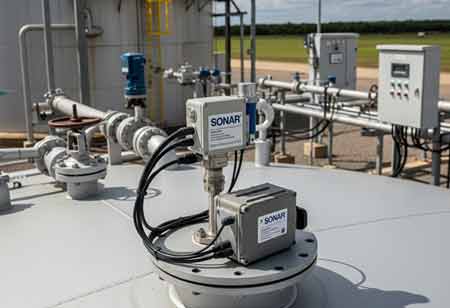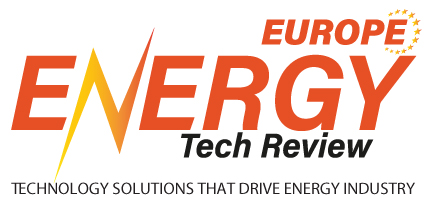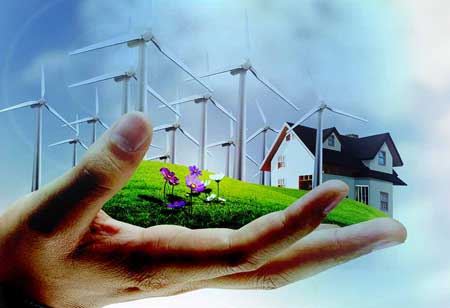CLOSE
Specials
I agree We use cookies on this website to enhance your user experience. By clicking any link on this page you are giving your consent for us to set cookies. More info
Be first to read the latest tech news, Industry Leader's Insights, and CIO interviews of medium and large enterprises exclusively from Energy Tech Review
Thank you for Subscribing
The Future of Tank Monitoring in Energy Infrastructure
The evolution of tank monitoring in the energy sector has shifted from manual methods to advanced, data-driven solutions, utilizing sonar technology for real-time insights, enhanced safety, and operational efficiency.

By
Energy Tech Review | Friday, October 31, 2025
Stay ahead of the industry with exclusive feature stories on the top companies, expert insights and the latest news delivered straight to your inbox. Subscribe today.
The way the energy industry handles its most valuable assets—the contents of its tanks—has changed due to its intricate logistics and network of storage facilities. Tank monitoring has evolved from a simple, labor-intensive procedure to a complex, data-driven field. This change has improved safety and adherence to environmental requirements in addition to increasing operating efficiency.
From Manual Inspection to Automated Gauging
Traditionally, monitoring the level of liquids in storage tanks was a manual and often perilous task. Workers, known as "gaugers," had to physically climb tanks with measuring tapes or sounding rods to determine the liquid level. This process was not only time-consuming and prone to human error but also exposed personnel to hazardous environments. The data collected was a snapshot in time, offering no real-time visibility into inventory changes. This method provided a limited and often inaccurate representation of a tank's contents, making it difficult to manage supply chains, schedule deliveries, and prevent overfills or runouts.
The first significant leap forward came with the introduction of mechanical and electromechanical systems. Devices like float-and-tape gauges provided a continuous, but still local, reading of the tank level. While a vast improvement over manual methods, these systems were still susceptible to mechanical failures and required on-site inspection to read the gauge. The true revolution began with the advent of automated tank gauging (ATG) systems. These systems utilized various technologies, including pressure sensors, radar, and ultrasonic transmitters, to automatically measure tank levels and transmit the data to a central location. This marked the beginning of real-time monitoring, paving the way for modern, interconnected tank management.
The Rise of Sonar-Based Intelligence
While various ATG technologies offer significant benefits, sonar-based systems have emerged as a powerful tool for modernizing legacy tank farms and storage systems. Sonar, or sound navigation and ranging, utilizes sound waves to measure distance and create detailed maps of an environment. In the context of tank monitoring, a sonar transducer mounted on the exterior of a tank emits an ultrasonic pulse that travels through the tank wall and into the liquid. The pulse reflects off the liquid's surface, and the time it takes for the echo to return is used to calculate the liquid level with remarkable accuracy.
Unlike intrusive probes or sensors that must be installed inside the tank, sonar sensors are externally mounted, meaning they do not come into direct contact with the stored liquid. This eliminates the risk of contamination, corrosion, or damage from harsh chemicals, making them exceptionally reliable in demanding environments. This capability is particularly valuable for retrofitting older, existing tanks without requiring a complete system shutdown or costly internal modifications. It allows for the seamless upgrade of legacy infrastructure, bringing it into the digital age without significant operational disruption. Furthermore, sonar can provide insights beyond just the liquid level, such as detecting sludge or sediment buildup on the tank floor, which is crucial for maintenance and asset integrity.
Integration with Modern Platforms
The initial destination for real-time tank data is often a SCADA (Supervisory Control and Data Acquisition) system. SCADA systems serve as the central nervous system for industrial operations, providing a human-machine interface (HMI) for operators to monitor and control processes. The SCADA system receives tank level data from the sonar sensors and displays it on a dashboard, allowing operators to see a live view of their tank farm. It can be configured to generate alarms and notifications if levels exceed or fall below predefined thresholds, enabling operators to take immediate action to prevent incidents. The SCADA platform aggregates data from multiple tanks and locations, providing a unified view of the entire storage network.
While SCADA systems have traditionally been a closed-loop control environment, the Industrial Internet of Things (IIoT) has opened up new possibilities. IIoT sensors, including sonar-based devices, are wirelessly connected and capable of transmitting a much richer stream of data. This data, which can include not only liquid levels but also temperature, pressure, and information on the tank's structural integrity, is transmitted via gateways to the cloud. This provides a more granular and continuous flow of information, moving beyond simple supervisory control to a more comprehensive understanding of asset health and operational performance. The IIoT layer acts as the bridge, collecting data from a distributed network of sensors and routing it to more powerful, centralized platforms.
The final piece of this modern architecture is cloud-based analytics platforms. Once the data is in the cloud, it can be processed and analyzed on a massive scale. These platforms leverage advanced algorithms and machine learning to identify trends, predict future inventory levels, and optimize logistics. The flow of information is a continuous loop: data is collected by the sonar sensors, transmitted via the IIoT network, visualized and monitored by the SCADA system, and then processed and enriched by the cloud analytics platform. This creates a data-driven ecosystem where intelligence from the tank floor is transformed into actionable insights that can be accessed from anywhere, enabling a new era of remote monitoring, supply chain optimization, and proactive asset management. This interconnected system represents a holistic approach to managing energy infrastructure, where every tank is a smart asset contributing to a more efficient and resilient operation.
The transition from manual tank monitoring methods to automated sonar-based systems exemplifies the energy sector's digital evolution, transforming a previously slow and perilous operation into a precise, data-driven discipline. This integrated framework not only offers unparalleled real-time oversight and control but also establishes the groundwork for a more robust, efficient, and sustainable energy infrastructure. Projections indicate an acceleration of this trend, as the insights derived from intelligent tank farms will stimulate further advancements in supply chain optimization, predictive maintenance, and operational safety, thereby solidifying data's role as the most vital asset in managing physical resources.

Copyright © 2025 Energy Tech Review. All rights reserved






